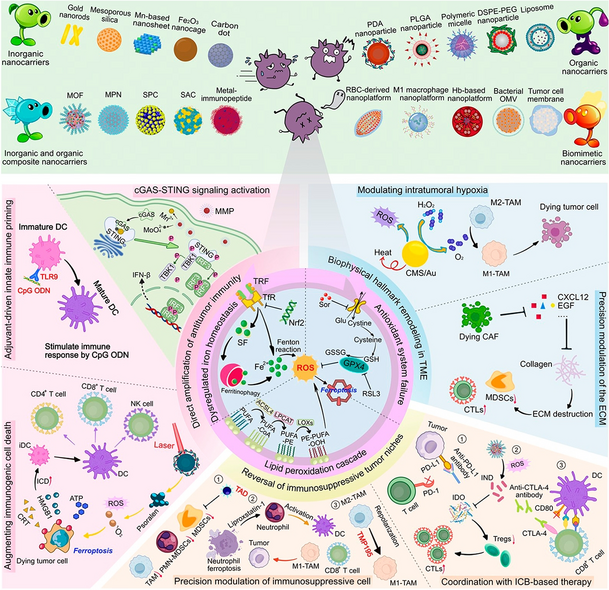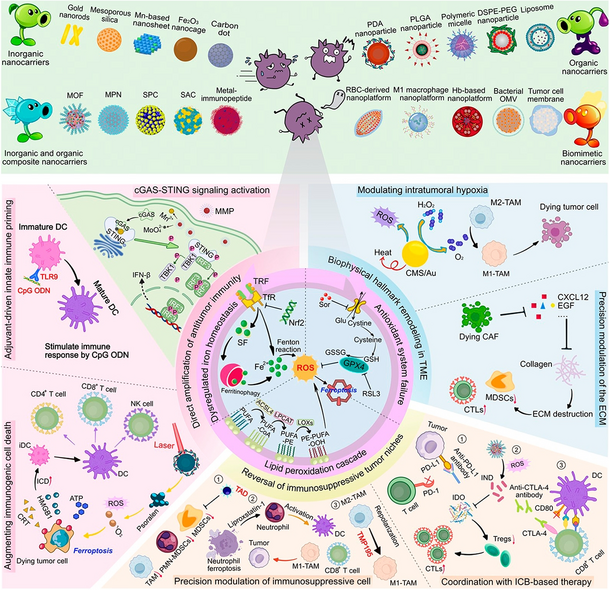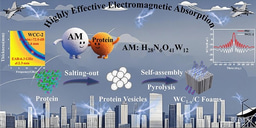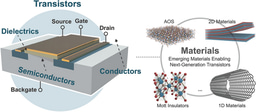Synergistic Ferroptosis–Immunotherapy Nanoplatforms: Multidimensional Engineering for Tumor Microenvironment Remodeling and Therapeutic Optimization
Published in Bioengineering & Biotechnology, Cancer, and Materials

As cancer immunotherapy continues to evolve, the immunosuppressive tumor microenvironment (TME) remains a major barrier to effective treatment. Now, researchers from Chengdu University, led by Dr. Xiao Wei and Dr. Mingzhu Song, have presented a comprehensive review on synergistic ferroptosis–immunotherapy nanoplatforms. This work offers a systematic roadmap for integrating ferroptosis induction with immunotherapy to overcome TME resistance and enhance antitumor immunity.
Why Ferroptosis–Immunotherapy Synergy Matters
- Immunogenic Cell Death (ICD): Ferroptosis not only kills tumor cells but also triggers ICD, releasing DAMPs that activate dendritic cells and T cells.
- TME Reprogramming: By disrupting immunosuppressive niches and enhancing immune cell infiltration, ferroptosis turns “cold” tumors “hot.”
- Systemic Immunity: The synergy between ferroptosis and immunotherapy can inhibit primary tumors, prevent metastasis, and establish long-term immune memory.
Innovative Design and Features
- Nanocarrier Types: The review covers organic (liposomes, micelles), inorganic (iron oxide, gold), composite (MOFs, MPNs), and biomimetic (cell membrane-coated) platforms.
- Multidimensional Engineering: Rational design principles include material selection, structural configuration, physicochemical modulation, multifunctional integration, and AI-enabled optimization.
- Stimuli-Responsive Release: pH, redox, enzyme, and light-responsive systems ensure tumor-specific drug activation.
- Imaging Integration: MRI, fluorescence, photoacoustic, and ultrasound imaging enable real-time therapeutic monitoring.
Applications and Future Outlook
- Direct Immune Amplification: Nanoplatforms enhance ICD, activate cGAS-STING signaling, and deliver immune adjuvants like CpG ODNs.
- Immunosuppressive Niche Disruption: Combined with ICB (anti-PD-1/PD-L1, anti-CTLA-4, IDO inhibitors), ferroptosis reverses TME immunosuppression.
- TME Remodeling: Hypoxia alleviation and ECM degradation improve immune cell infiltration and drug penetration.
- Clinical Perspectives: FDA-approved drugs (e.g., sorafenib, artesunate) and nanomedicines (e.g., mRNA vaccines, TLR agonists) are paving the way for clinical translation.
This comprehensive review provides a scientific basis for the rational design of ferroptosis–immunotherapy nanoplatforms. It highlights the importance of interdisciplinary collaboration in materials science, immunology, and oncology to accelerate clinical translation. Stay tuned for more groundbreaking work from Dr. Xiao Wei and Dr. Mingzhu Song at Chengdu University!
Follow the Topic
-
Nano-Micro Letters

Nano-Micro Letters is a peer-reviewed, international, interdisciplinary and open-access journal that focus on science, experiments, engineering, technologies and applications of nano- or microscale structure and system in physics, chemistry, biology, material science, and pharmacy.
Ask the Editor – Inflammation, Metastasis, Cancer Microenvironment and Tumour Immunology
Got a question for the editor about inflammation, metastasis, or tumour immunology? Ask it here!
Continue reading announcement





Please sign in or register for FREE
If you are a registered user on Research Communities by Springer Nature, please sign in